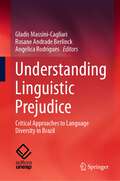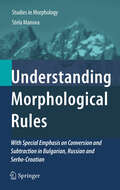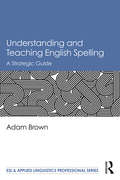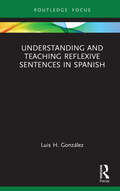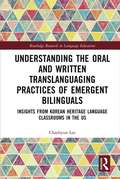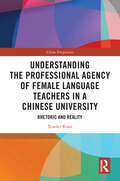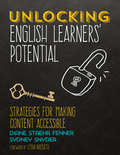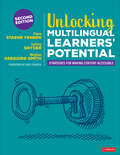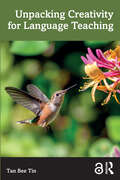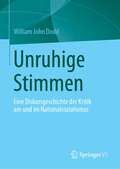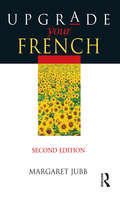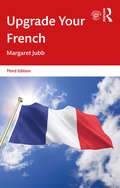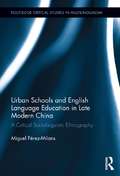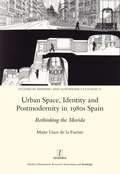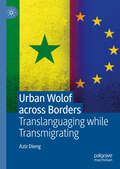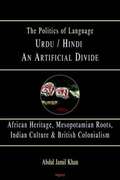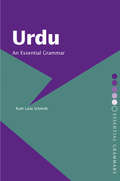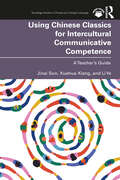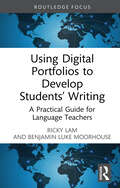- Table View
- List View
Understanding Language in Diverse Classrooms: A Primer for All Teachers
by Marilyn Shatz Louise C. WilkinsonWith the increasing linguistic and cultural diversity of students in U. S. schools, all teachers, regardless of the content area or grade they teach, need research-based strategies for assisting all students to gain English proficiency. This practical, concise guide shows teachers what they need to know about language, how it is learned, how it is used, and how teaching about it can be incorporated into lessons throughout the curriculum. Understanding Language in Diverse Classrooms offers a model of how learning takes place and describes the critical role of teachers in that model. It includes comparison charts showing how some of the most common heritage languages represented among present-day students compare with English, and it provides examples of hands-on materials including checklists, rating scales, and sample lessons to help teachers prepare to teach all their students in diverse classrooms. Each chapter ends with questions to stimulate discussion and reflection on major chapter points, to enable readers to review and evaluate the information and then integrate it into their own practice.
Understanding Linguistic Prejudice: Critical Approaches to Language Diversity in Brazil
by Gladis Massini-Cagliari Rosane Andrade Berlinck Angelica RodriguesThis book discusses linguistic diversity, linguistic prejudice, and language variation and change from a Global South perspective by analyzing Brazilian Portuguese, Brazilian Sign Language (LIBRAS) and indigenous languages spoken in Brazil. It brings together studies and reflections on linguistic prejudice and social discrimination based on data and examples from Brazil and aims to bridge the gap between academic findings and popular notions related to linguistic diversity to promote language diversity and fight linguistic intolerance. Chapters in this volume present contributions to understand the origins and motivations of linguistic prejudice and foster awareness of entrenched opinions regarding linguistic diversity. The first part of the book brings together chapters analyzing basic sociolinguistic questions concerning linguistic prejudice based on theoretical discussions and qualitative research. The second part is composed of chapters that analyze linguistic prejudice in Brazil in major communities that speak Brazilian Portuguese varieties and minor communities that speak native and sign languages. Understanding Linguistic Prejudice: Critical Approaches to Language Diversity in Brazil will be a valuable resource for researchers in sociolinguistics interested in language diversity, language justice and language policy. It will also be of interest to sociologists, anthropologists and other social scientist interested in the relationship between language, diversity, equity and inclusion.
Understanding Morphological Rules
by Stela ManovaThis volume analyzes morphological and morphonological phenomena from a number of distinct Slavic languages. It does so in an innovative manner, yet also positions the analysis in the context of current morphological debates. It is thus a valuable contribution both to comparative Slavic morphology and general morphological theory. Moreover, the book is the first attempt at a theory of conversion and subtraction relevant to languages with rich inflectional morphology. It contributes to our structural understanding of the nature of word. As the first illustration of subtraction with examples from southern Slavic languages, it is an excellent source of specialist data. The book's theoretical framework is easily accessible and applicable to other languages, which makes it attractive to researchers on Slavic languages and general linguists alike. The volume will also appeal to general morphologists, typologists, and advanced students in linguistics.
Understanding and Teaching English Spelling: A Strategic Guide (ESL & Applied Linguistics Professional Series)
by Adam BrownConcise and engaging, this text provides pre-service and practicing English language teachers with the knowledge they need to successfully teach the spelling of English. Offering context and explanation for the English spelling system as well as uniquely addressing specific problems in learning the spelling of English words, this book empowers readers with strategies for coping with these problems. Divided into six accessible sections, Brown covers the history of English spelling, the influence of technology on spelling, the role of punctuation, the features of present-day English spelling, teaching strategies for coping with difficult spelling, and the future of spelling and literacy. The short, digestible chapters include practical learning objectives and end-of-chapter exercises to help teachers understand and explain English spelling concepts.
Understanding and Teaching Reflexive Sentences in Spanish
by Luis H. GonzálezUnderstanding and Teaching Reflexive Sentences in Spanish provides a fresh, simple, and novel approach to understanding and teaching the use of the intransitivizing se. Understanding reflexive sentences can be challenging for learners of Spanish. Instead of expecting learners to memorize multiple rules, the author offers one simple rule that allows learners to intuitively understand and use reflexive sentences. Sample exercises for students at all levels of language proficiency are also provided to practice and internalize the new approach. This book will be of interest to teachers and learners of any second language, as well as linguists interested in second language acquisition or in second language teaching or pedagogy.
Understanding and Teaching the Indirect Object in Spanish (Verber, Verbed Grammar)
by Luis H. GonzálezUnderstanding and Teaching the Indirect Object in Spanish presents an easy-to-understand approach to all aspects of direct and indirect objects in Spanish. Distinguishing between direct and indirect objects can pose challenges for learners and is almost impossible to do using the tools that linguists have traditionally used. This book offers two simple, all-encompassing inferences that allow learners to tackle this area of language by intuitively inferring the distinction, as native speakers do, between verber and verbed. This book will be of interest to teachers and learners of Spanish and other second languages, as well as linguists interested in argument structure, second language acquisition, second language teaching or pedagogy, and multilingualism.
Understanding the Oral and Written Translanguaging Practices of Emergent Bilinguals: Insights from Korean Heritage Language Classrooms in the US (Routledge Research in Language Education)
by Chaehyun LeeDetailing qualitative research undertaken with elementary-grade children in a Korean heritage language school in the US, this text provides unique insight into the translanguaging practices and preferences of young, emergent bilinguals in a minority language group. Understanding the Oral and Written Translanguaging Practices of Emergent Bilinguals examines the role of socio-cultural influences on emergent bilinguals’ language use and development. Particular attention is paid to the role of immigrant parental involvement and engagement in their bilingual children’s language learning and academic performance. Presenting data from classroom audio recordings, writing, and drawing samples, as well as semi-structured interviews with children and parents, the book identifies important implications for the education of emergent bilinguals to better support their overall language and literacy development. This text will primarily be of interest to doctoral students, researchers, and scholars with an interest in bilingual education, biliteracy, and early literacy development more broadly. Those interested in applied linguistics, the Korean language, and multicultural education will also benefit from this volume.
Understanding the Professional Agency of Female Language Teachers in a Chinese University: Rhetoric and Reality (China Perspectives)
by Xiaolei RuanCentering on a qualitative study of three female English teachers in Shanghai, China, the book explores female language teachers' perceived discrepancies and agency exercised in their teaching, research and teacher learning practices. By adopting multiple research methods, such as narrative questionnaire, metaphor, timeline, interview and classroom observation, this study reveals that female language teachers’ agency is a dynamic entity manifested in the ongoing negotiation of agency belief, agency practice, and agency inclination, as well as the interaction of individual and the environment. Though there are certain limitations concerning representativeness and generalizability, the author provides a thick description of how female language teachers in China are exercising agency to fulfill their career development, which offers insightful suggestions to language education in both China and broader areas globally. The book will appeal to researchers studying teacher education and foreign (English) language teaching, university teachers, especially female foreign language teachers, PhD students and graduate students, as well as career women.
Unlocking English Learners' Potential: Strategies for Making Content Accessible
by Diane Staehr Fenner Sydney C. Snyder“Schools are not intentionally equitable places for English learners to achieve, but they could be if the right system of support were put in place. Diane Staehr Fenner and Sydney Snyder recommend just such a system. Not only does it have significant potential for providing fuller access to the core curriculum, it also provides a path for teachers to travel as they navigate the individual needs of students and support their learning journeys.” —Douglas Fisher, Coauthor of Visible Learning for Literacy A once-in-a-generation text for assisting a new generation of students Content teachers and ESOL teachers, take special note: if you’re looking for a single resource to help your English learners meet the same challenging content standards as their English-proficient peers, your search is complete. Just dip into this toolbox of strategies, examples, templates, and activities from EL authorities Diane Staehr Fenner and Sydney Snyder. The best part? Unlocking English Learners’ Potential supports teachers across all levels of experience. The question is not if English learners can succeed in today’s more rigorous classrooms, but how. Unlocking English Learners’ Potential is all about the how: How to scaffold ELs’ instruction across content and grade levels How to promote ELs’ oral language development and academic language How to help ELs analyze text through close reading and text-dependent questions How to build ELs’ background knowledge How to design and use formative assessment with ELs Along the way, you’ll build the collaboration, advocacy, and leadership skills that we all need if we’re to fully support our English learners. After all, any one of us with at least one student acquiring English is now a teacher of ELs.
Unlocking English Learners' Potential: Strategies for Making Content Accessible
by Diane Staehr Fenner Sydney C. Snyder“Schools are not intentionally equitable places for English learners to achieve, but they could be if the right system of support were put in place. Diane Staehr Fenner and Sydney Snyder recommend just such a system. Not only does it have significant potential for providing fuller access to the core curriculum, it also provides a path for teachers to travel as they navigate the individual needs of students and support their learning journeys.” —Douglas Fisher, Coauthor of Visible Learning for Literacy A once-in-a-generation text for assisting a new generation of students Content teachers and ESOL teachers, take special note: if you’re looking for a single resource to help your English learners meet the same challenging content standards as their English-proficient peers, your search is complete. Just dip into this toolbox of strategies, examples, templates, and activities from EL authorities Diane Staehr Fenner and Sydney Snyder. The best part? Unlocking English Learners’ Potential supports teachers across all levels of experience. The question is not if English learners can succeed in today’s more rigorous classrooms, but how. Unlocking English Learners’ Potential is all about the how: How to scaffold ELs’ instruction across content and grade levels How to promote ELs’ oral language development and academic language How to help ELs analyze text through close reading and text-dependent questions How to build ELs’ background knowledge How to design and use formative assessment with ELs Along the way, you’ll build the collaboration, advocacy, and leadership skills that we all need if we’re to fully support our English learners. After all, any one of us with at least one student acquiring English is now a teacher of ELs.
Unlocking Multilingual Learners’ Potential: Strategies for Making Content Accessible
by Diane Staehr Fenner Sydney Cail Snyder Meghan Gregoire-SmithBring classroom content to life for multilingual learners In this eagerly anticipated revision of their bestselling book, authors Diane Staehr Fenner, Sydney Snyder, and Meghan Gregoire-Smith share dynamic, research-backed strategies that every educator of multilingual learners (MLs) can add to their repertoire. Including more of what educators loved from the first edition—authentic classroom examples, a wide variety of research-based instructional strategies, and practical tools to implement across grade levels and content areas—this is the ultimate practical guide to unlocking the potential of MLs in K-12 classrooms. With fresh graphics and eye-catching colors, this thoroughly revised edition also includes: Considerations for newcomers and students with interrupted or no formal education (SLIFE) An added chapter on building scaffolded instruction and peer learning opportunities into MLs’ academic reading and writing activities Additional opportunities for reflection and application A new unit planning template aligned with research-based instructional practices, including a completed example unit Situated within five core beliefs that frame the must-haves for MLs’ equitable and excellent education, Unlocking Multilingual Learners′ Potential is a guide to research-based practices and a toolbox of strategies every educator can implement to make content accessible and increase language proficiency among MLs.
Unlocking Multilingual Learners’ Potential: Strategies for Making Content Accessible
by Diane Staehr Fenner Sydney Cail Snyder Meghan Gregoire-SmithBring classroom content to life for multilingual learners In this eagerly anticipated revision of their bestselling book, authors Diane Staehr Fenner, Sydney Snyder, and Meghan Gregoire-Smith share dynamic, research-backed strategies that every educator of multilingual learners (MLs) can add to their repertoire. Including more of what educators loved from the first edition—authentic classroom examples, a wide variety of research-based instructional strategies, and practical tools to implement across grade levels and content areas—this is the ultimate practical guide to unlocking the potential of MLs in K-12 classrooms. With fresh graphics and eye-catching colors, this thoroughly revised edition also includes: Considerations for newcomers and students with interrupted or no formal education (SLIFE) An added chapter on building scaffolded instruction and peer learning opportunities into MLs’ academic reading and writing activities Additional opportunities for reflection and application A new unit planning template aligned with research-based instructional practices, including a completed example unit Situated within five core beliefs that frame the must-haves for MLs’ equitable and excellent education, Unlocking Multilingual Learners′ Potential is a guide to research-based practices and a toolbox of strategies every educator can implement to make content accessible and increase language proficiency among MLs.
Unpacking Creativity for Language Teaching
by Tan Bee TinBefore unlocking creativity, we must first unpack what it means. In this book, creativity is unravelled from various perspectives and the relevance for language teaching and learning is explored. Tin offers a coherent discussion of creativity, adopting an inclusive and integrated but, at the same time, focused approach to creativity. Divided into 12 chapters, the book covers: A critical review of the way the term ‘creativity’ is used, defined and written about in various disciplines Various models and theories of creativity, the product- and process-oriented views of creativity and their relevance for language teaching Three pillars on which creative language pedagogy should be based Over 60 practical tasks, applying theoretical arguments and principles of creativity to language teaching and learning Based on the author’s own practice and research on creativity over the last two decades, the book provides exciting new ideas for scholars and practitioners interested in creativity and creative language pedagogy. The book serves as an important contribution for students, teachers and scholars in the field of applied linguistics, language teaching and education.
Unraveling the complexity of SE (Studies in Natural Language and Linguistic Theory #99)
by Grant Armstrong Jonathan E. MacDonaldThis book makes a novel contribution to our understanding of Romance SE constructions by combining both diachronic and synchronic theoretical perspectives along with a range of empirical data from different languages and dialects. The collection, divided into four sections, proposes that SE constructions may be divided into one class that is the result of grammaticalization of a reflexive pronoun up the syntactic tree, from Voice and above, and another class that has resulted from the reanalysis of reflexive and anticausative morphemes as an argument expletive or verbal morpheme generated in positions from Voice and below. The contributions, while varied in both empirical content and theoretical approach, all serve to highlight different aspects of the overarching idea that SE constructions have evolved from these two distinct grammaticalization paths. The book appeals to researchers and academics in the field and closes with a unified approach to various SE constructions that makes important use of its status as a verbal morpheme. In addition to aligning a novel string of empirical contributions under a new theoretical umbrella, a clear research direction emerges from this volume based on the morphosyntactic nature of SE itself: Is it a clitic, an agreement morpheme, or a verbal morpheme?
Unruhige Stimmen: Eine Diskursgeschichte der Kritik am und im Nationalsozialismus
by William John DoddIn dieser Diskursgeschichte analysiert W. J. Dodd die "unruhigen Stimmen" von Gegnern, deren zeitgenössische Kritik am Nationalsozialismus sich aus Positionen des territorialen und inneren Exils auf die "Sprache des Nationalsozialismus" konzentrierte. Die einzelnen Kapitel befassen sich mit den "Vorläufer"-Diskursen, dem öffentlichen Diskurs der Nazis von 1933 bis 1945, den Zeugnissen der "unruhigen Stimmen" im Ausland sowie in privaten und veröffentlichten Texten im "Reich", den Versuchen zur "Entnazifizierung der Sprache" (1945-49) und den Hinterlassenschaften der Nazi-Vergangenheit in einem retrospektiven Diskurs der "Aufarbeitung" der Nazi-Vergangenheit. In der Zeit nach 1945 konzentriert sich das Buch auf die Anfechtung der "befleckten Sprache" und die Instrumentalisierung der NS-Vergangenheit sowie auf das Fortbestehen sprachlicher Tabus im zeitgenössischen deutschen Sprachgebrauch. Das Buch, das durchgehend in englischer Übersetzung vorliegt, ist eine unschätzbare Quelle für Wissenschaftler der Diskursanalyse, der Soziolinguistik und der deutschen Geschichte und Kultur sowie für Leser mit einem allgemeinen Interesse an Sprache und Politik.
Upgrade Your French
by Margaret JubbUpgrade your French is the ideal guide for students wanting to rapidly improve their written French. It offers a stimulating thirty day revision programme that is guaranteed to improve your skills. In the countdown to exams, students should simply spend between 30 minutes to an hour a day with this book, and see their mark go up a grade! This short revision guide focuses on three key strategies for improving your written French: - Eliminating common errors and slips of the pen - Increasing and consolidating vocabulary - Encouraging more varied language use The new edition is fully revised and includes a new introduction discussing the essential differences between written and spoken French and a new chapter on comparatives and superlatives. This is the ideal book for all intermediate students looking for a simple way to improve their French fast.
Upgrade Your French
by Margaret JubbUpgrade Your French is the ideal guide for students looking to improve their written French rapidly. It offers a complete revision programme to improve your skills, focusing on three key strategies for improving your written French: Eliminating common errors Increasing and consolidating vocabulary Using a wider range of expression and sentence structure This third edition includes enhanced coverage of the subjunctive and a new section on prepositions, new revision exercises at the end of each chapter (including translation sentences), and a companion website with further practice exercises. This is the ideal book for all intermediate students looking for a simple way to improve their French fast.
Urban Schools and English Language Education in Late Modern China: A Critical Sociolinguistic Ethnography (Routledge Critical Studies in Multilingualism)
by Miguel Perez-MilansShortlisted for the 2014 BAAL Book Prize This book explores the meaning of modernization in contemporary Chinese education. It examines the implications of the implementation of reforms in English language education for experimental-urban schools in the People’s Republic of China. Pérez-Milans sheds light on how national, linguistic, and cultural ideologies linked to modernization are being institutionally (re)produced, legitimated, and inter-personally negotiated through everyday practice in the current context of Chinese educational reforms. He places special emphasis on those reforms regarding English language education, with respect to the economic processes of globalization that are shaping (and being shaped by) the contemporary Chinese nation-state. In particular, the book analyzes the processes of institutional categorization of the "good experimental school", the "good student", and the "appropriate knowledge" that emerge from the daily discursive organization of those schools, with special attention to the related contradictions, uncertainties and dilemmas. Thus, it provides an account of the on-going cultural processes of change faced by contemporary Chinese educational institutions under conditions of late modernity. Winner of The University of Hong Kong's Faculty Early Career Research Output Award for outstanding book publication, by the Faculty of Education
Urban Space, Identity and Postmodernity in 1980s Spain: Rethinking the Movida
by MariteUsozdela FuenteDuring the 1980s, the urban youth movement known as la movida transformed the Spanish cultural landscape, particularly in the country's capital, Madrid. After a four-decade long dictatorship, artists and thinkers sought to make the most of their newly found freedoms. The vibrancy, optimism and aesthetic heterogeneity of the period are best captured in contemporary ephemera - in the fanzines and magazines that provided movida participants with an immediate and largely unmediated outlet for their creative experiments. Among them, monthly arts magazine La Luna de Madrid is arguably the most iconic, and its preoccupation with urban space, identity, and postmodernity suggests that la movida was indeed more than 'just a teardrop in the rain', as some of its critics have suggested.
Urban Wolof across Borders: Translanguaging while Transmigrating
by Aziz DiengThis book takes urban Wolof beyond Senegal to consider the effects of mobility on language and examine how the diasporans engage in their daily language practices as transmigrants. The parallel between languaging and migrating underpins the author's argument, as he examines the dynamicity of languaging at both micro and macro levels, as speakers navigate across spaces and languages. Moving away from a code-based approach, the author makes a compelling case that the urbanite, rather than shuttling between codes, deploys instead idiolectal features from a unique linguistic repertoire which comprises at once semiotic, cognitive, and language features. His indigenous approach affords novel perspectives in linguistic ethnography and complements the Euro-Western methodologies.
Urdu/Hindi: Evolution from African Genes, Mesopotamian Roots, and Indian Culture
by Abdul Jamil KhanThe lingua franca of the Indo-Pakistani people is one language, claims Khan, called Hindi when written in Nagari and Urdu when written in Arabic. He says it is not descended from Sanskrit, as conventionally believed, but is 10-12,000 years old and was influenced early by the Austric-Munda and Dravidian language families. Leaving aside any religious argument, he buttresses his theory with evidence from evolution, Sumerian, and the European concept of mythical races linked to linguistic families. His experience teaching pediatrics and infant speech development led him to the study of linguistics and history. Annotation ©2006 Book News, Inc. , Portland, OR (booknews. com)
Urdu: An Essential Grammar (Routledge Essential Grammars)
by Ruth Laila SchmidtUrdu: An Essential Grammar is a reference guide to the most important aspects of the language as it is used by native speakers today.The complexities of Urdu are set out in short, readable sections. Explanations contain minimal jargon and emphasis has been placed on the aspects of Urdu that pose a particular challenge for English-speaking students.Features include:* language examples throughout in both Urdu script and romanization* user-friendly layout* detailed contents list* comprehensive index.Urdu: An Essential Grammar presents a fresh and accessible description of the language and will prove invaluable to students at all levels.
Using Chinese Classics for Intercultural Communicative Competence: A Teacher’s Guide (Routledge Studies in Chinese as a Foreign Language)
by Xuehua Xiang Jinai Sun Li YeUsing Chinese Classics for Intercultural Communicative Competence presents new strategies and tools for integrating Mandarin language teaching with fostering intercultural competencies through contemporary, global lenses on Chinese classic texts.Chinese classic texts are canonical works in Chinese culture published before 1911. They offer a window into deeply held cultural values which learners of the Chinese language would benefit from studying to facilitate meaningful intercultural dialogues. With chapters covering classic Chinese texts, such as Journey to the West, Dream of the Red Chamber, and The Romance of the Three Kingdoms, this book will demonstrate the value, importance, and feasibility of teaching Chinese classic works for ICC development in the Chinese world language classroom, and equip teachers with carefully planned, classroom-tested lesson models that demonstrate the innovative, integrative models advocated in this book.This book will be valuable for pre- and in-service Mandarin Chinese teachers across various institutional settings at different levels, looking for ready materials and professional development resources. The book can also be used as core material for teacher training programs.
Using Digital Portfolios to Develop Students’ Writing: A Practical Guide for Language Teachers (Routledge Research in Language Education)
by Ricky Lam Benjamin Luke MoorhouseThis book equips pre-service teachers, research postgraduate students, teacher educators, and language specialists with specific knowledge and skills about the principles, research, and applications of digital portfolios within the EFL writing contexts. While most digital portfolio scholarship focuses on higher education, this book targets primary-level and secondary-level school audiences, namely pre-service teachers, teacher educators, and Ministry of Education staff members with a focus on EFL writing. The rationale behind this design is that the published literature on digital portfolios tends to be generic and one-size-fits-all; there has been scant published scholarship about the development of digital portfolio literacy among teachers and pupils, which could enable them to upgrade the teaching and learning of writing in a larger EFL environment. This volume fills this gap by illustrating the why, what, and how aspects of digital portfolios in ten reader-friendly chapters. Guiding educators to enrich their pedagogical repertoire via the portfolio approach, this book emphasises a healthy balance between principles, research, and practice. It is an easy-to-follow guide to setting up digital portfolio systems and coaching pupils to improve writing, ensuring the dissemination of digital portfolios with high fidelity.
Using French Vocabulary
by Jean H. DuffyThis textbook provides a comprehensive and structured vocabulary for all levels of undergraduate French courses. It offers a broad coverage of the concrete and abstract vocabulary relating to the physical, cultural, social, commercial and political environment, as well as exposure to commonly encountered technical terminology. The book is divided into twenty thematic sections for easy integration into modular courses. Within each section, words and phrases have been grouped into units and broadly "graded" according to likely usefulness and difficulty. There are 750 accompanying exercises for private study and classroom use.

